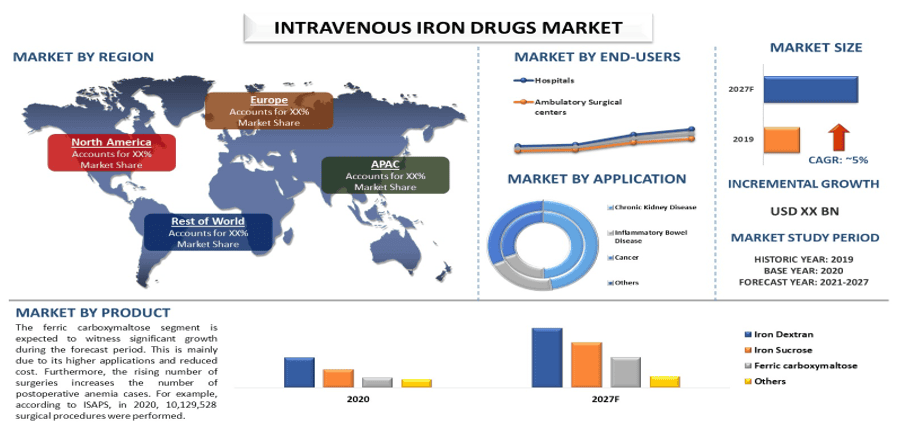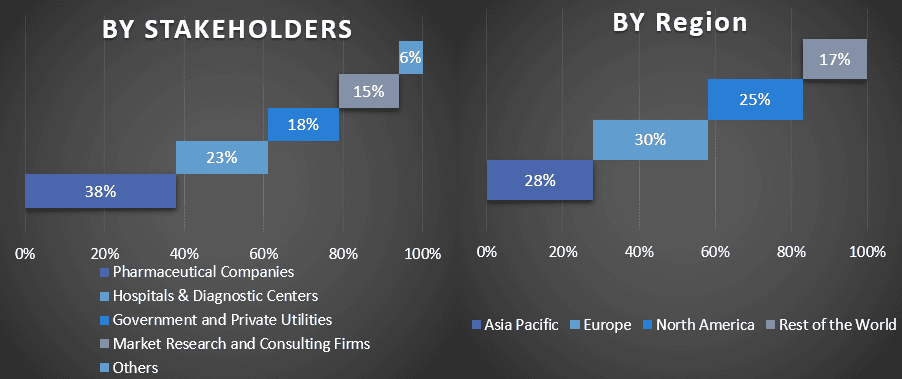静脈内鉄剤市場:現状分析と予測 (2021年~2027年)
強調製品(デキストラン鉄、スクロース鉄、カルボキシマルトース鉄など);用途(慢性腎臓病、炎症性腸疾患、癌など);エンドユーザー(病院、外来手術センターなど);地域/国

静脈内鉄剤市場は大きな市場需要を獲得しており、予測期間中に年平均成長率8%で成長すると予想されています。貧血とは、血液中に十分な赤血球がない状態のことです。赤血球には鉄分とヘモグロビンが含まれており、ヘモグロビンは酸素を血流に乗せて全身の臓器に運ぶタンパク質です。世界中で貧血の症例数が増加しており、鉄分をベースとしたサプリメントの需要が高まっています。さらに、ほとんどの女性は月経中や妊娠中に貧血に苦しんでいます。例えば、WHOによると、2019年の世界の生殖年齢の女性における貧血の有病率は29.9%で、15~49歳の女性5億人以上に相当します。貧血の有病率は、妊娠していない生殖年齢の女性で29.6%、妊娠中の女性で36.5%でした。さらに、手術件数の増加や慢性疾患の有病率の増加が、静脈内鉄剤市場の成長に寄与しています。
COVID-19は、各国が2020年前半にロックダウンを実施せざるを得なかったため、静脈内鉄剤市場の成長を鈍化させました。厳しい政府規制とCOVID-19症例の増加により、病院はCOVID-19の治療にリソースを投入し、パンデミック期間中は不要不急の予約を延期しました。
Vifor Pharma Management Ltd.、AMAG Pharmaceuticals、第一三共株式会社、Sanofi S.A.、Pharmacosmos A/S、Shield Therapeutics Plc、AbbVie、Rockwell Medical、Americal Reagent、Keryx Biopharmaceuticals Inc
は、市場の主要なプレーヤーの一部です。これらのプレーヤーは、ハイテクで革新的な製品/技術で顧客を支援するために、いくつかの戦略的対策を講じています。
レポートで提示された洞察
「製品別では、カルボキシマルトース第二鉄カテゴリーが予測期間中にかなりの成長を遂げると予想されます」
製品に基づいて、市場はデキストラン鉄、スクロース鉄、カルボキシマルトース第二鉄、その他に分類されています。これらのうち、カルボキシマルトース第二鉄カテゴリーは、予測期間中に大幅な成長を遂げると予想されます。この化合物は安定しており、薬物の免疫原性ポテンシャルが最小限であり、薬物の注入速度が高いため、静脈内鉄市場におけるセグメントの大きな成長につながっています。さらに、頻繁な製品発売も、IV鉄市場におけるセグメントのかなりの市場シェアに起因しています。例えば、2021年5月、第一三共株式会社とAmerican Regent, Inc.は、FDAが注射剤であるInjectafer®(カルボキシマルトース第二鉄注射剤)の単回1000 mg投与オプションを承認したことを発表しました。これは、経口鉄に不耐性があるか、経口鉄に満足のいく反応が得られなかったか、非透析依存性慢性腎臓病(CKD)の成人患者の鉄欠乏性貧血の治療のための鉄補充製品です。
「アプリケーション別では、慢性腎臓病カテゴリーが2020年に大きなシェアを占めました」
アプリケーションに基づいて、市場は慢性腎臓病、炎症性腸疾患、癌、その他に分類されています。これらのうち、慢性腎臓病セグメントは、静脈内鉄市場で大きな成長を遂げると予想されています。腎不全とCKDの発生率の上昇は、透析の採用を増やし、その結果、体からの過度の失血と貧血を引き起こします。したがって、鉄サプリメントの需要が高まります。例えば、Kidney Care UKによると、英国では68,000人以上が腎不全の治療を受けています。
「エンドユーザー別では、専門がグローバル静脈内鉄剤市場の成長を牽引します」
エンドユーザーに基づいて、市場は病院、外来手術センター、その他に分類されています。病院は、予測期間中にかなりの市場成長を遂げると予測されています。これは、複数の疾患治療における病院の専門化と、熟練した専門家の存在によるものです。さらに、子供の貧血の割合が高いことは、病院の育児部門に子供のより良い治療のための圧力をかけ、サプリメント鉄市場におけるセグメントの成長に寄与する要因にもなっています。例えば、WHOによると、2019年の世界の貧血有病率は、6~59か月の子供で39.8%で、貧血の子供2億6,900万人に相当します。5歳未満の子供の貧血の有病率は、アフリカ地域で最も高く、60.2%でした。
「北米は予測期間中に大きな成長を遂げると予想されます」
北米は、有利な政府政策と医療費の増加により、有利な市場シェアを保持しており、地域の市場を牽引する主要な要因の一部です。さらに、慢性疾患の発生率の上昇も、地域における貧血の症例を増加させ、サプリメント鉄の需要の増加に起因しています。例えば、カナダ政府によると、約26万人のカナダ人が炎症性腸疾患に苦しんでいます。人はどの年齢でも発症する可能性がありますが、炎症性腸疾患は、10代後半から20代の人に診断されることがよくあります。主要な経済国の存在、可処分所得の増加、および地域における十分に確立された市場プレーヤーの存在は、地域における静脈内鉄の市場成長を促進するいくつかの要因です。
このレポートを購入する理由:
- この調査には、認証された主要な業界専門家によって検証された市場規模と予測分析が含まれています。
- このレポートは、全体的な業界のパフォーマンスをひと目で簡単に確認できます。
- このレポートは、主要なビジネス財務、製品ポートフォリオ、拡張戦略、および最近の開発に重点を置いて、著名な業界の同業者の詳細な分析を網羅しています。
- 業界で普及している推進要因、制約、主要なトレンド、および機会の詳細な調査。
- この調査では、さまざまなセグメントにわたる市場を包括的に網羅しています。
- 業界の地域レベルの詳細な分析。
カスタマイズオプション:
グローバル静脈内鉄剤市場は、要件またはその他の市場セグメントに応じてさらにカスタマイズできます。この他に、UMIは、お客様独自のビジネスニーズがあることを理解しているため、お客様の要件に完全に適合するレポートを入手するために、お気軽にお問い合わせください。
目次
グローバル静脈内鉄剤市場分析(2021年~2027年)に関する調査方法
グローバル静脈内鉄剤市場の過去の市場分析、現在の市場の推定、および将来の市場の予測は、主要地域における静脈内鉄剤の採用を構築および分析するために実施された3つの主要なステップでした。過去の市場数値を収集し、現在の市場規模を推定するために、徹底的な二次調査が実施されました。次に、これらの洞察を検証するために、多数の調査結果と仮定が考慮されました。さらに、グローバル静脈内鉄剤市場のバリューチェーン全体にわたる業界の専門家との広範な一次インタビューも実施されました。一次インタビューを通じて市場数値を仮定および検証した後、完全な市場規模を予測するためにトップダウン/ボトムアップアプローチを採用しました。その後、業界に関連するセグメントとサブセグメントの市場規模を推定および分析するために、市場の内訳とデータ三角測量法を採用しました。詳細な方法論を以下に説明します。
過去の市場規模の分析
ステップ1:二次ソースの詳細な調査:
静脈内鉄剤市場の過去の市場規模を取得するために、年次報告書および財務諸表、業績プレゼンテーション、プレスリリースなどの企業内部ソース、およびジャーナル、ニュースおよび記事、政府刊行物、競合他社の刊行物、セクターレポート、サードパーティデータベース、その他の信頼できる刊行物を含む外部ソースを通じて、詳細な二次調査を実施しました。
ステップ2:市場セグメンテーション:
静脈内鉄剤市場の過去の市場規模を取得した後、主要地域のさまざまなセグメントとサブセグメントに関する過去の市場の洞察とシェアを収集するために、詳細な二次分析を実施しました。レポートに含まれる主なセグメントは、製品、アプリケーション、およびエンドユーザーです。さらに、その地域におけるテストモデルの全体的な採用を評価するために、国レベルの分析を実施しました。
ステップ3:要因分析:
さまざまなセグメントおよびサブセグメントの過去の市場規模を取得した後、静脈内鉄剤市場の現在の市場規模を推定するために、詳細な要因分析を実施しました。さらに、さまざまな製品、アプリケーション、静脈内鉄剤のエンドユーザーなど、依存変数と独立変数を使用して要因分析を実施しました。世界の静脈内鉄剤市場セクターにおけるトップパートナーシップ、M&A、事業拡大、および製品の発売を考慮して、需要と供給側のシナリオについて徹底的な分析を実施しました。
現在の市場規模の推定と予測
現在の市場規模の算出:上記の3つのステップからの実用的な洞察に基づいて、現在の市場規模、グローバル静脈内鉄剤市場の主要なプレーヤー、およびセグメントの市場シェアに到達しました。必要なパーセントシェアの分割と市場の内訳はすべて、上記の二次的アプローチを使用して決定され、一次インタビューを通じて検証されました。
推定と予測:市場の推定と予測のために、ステークホルダーが利用できる推進要因とトレンド、制約、および機会を含むさまざまな要因に重みが割り当てられました。これらの要因を分析した後、関連する予測手法、つまり、トップダウン/ボトムアップアプローチを適用して、世界の主要市場全体のさまざまなセグメントおよびサブセグメントについて2027年頃の市場予測に到達しました。市場規模を推定するために採用された調査方法論には以下が含まれます。
- 収益(米ドル)と国内の主要市場全体での静脈内鉄剤市場の採用率の観点から見た、業界の市場規模
- 市場セグメントおよびサブセグメントのすべてのパーセントシェア、分割、および内訳
- 提供されるソリューションの観点から見た、グローバル静脈内鉄剤市場の主要なプレーヤー。また、この急速に成長している市場で競争するためにこれらのプレーヤーが採用している成長戦略
市場規模とシェアの検証
一次調査:主要地域全体のトップレベルのエグゼクティブ(CXO/VP、営業責任者、マーケティング責任者、オペレーション責任者、地域責任者、カントリーヘッドなど)を含む主要なオピニオンリーダー(KOL)との詳細なインタビューが実施されました。次に、一次調査の結果が要約され、述べられた仮説を証明するために統計分析が実行されました。一次調査からのインプットは二次調査の結果と統合され、その結果、情報が実用的な洞察に変わりました。
さまざまな地域における一次参加者の分割

市場エンジニアリング
グローバル静脈内鉄剤市場の各セグメントおよびサブセグメントの正確な統計数値に到達し、全体的な市場推定を完了するために、データ三角測量法が採用されました。グローバル静脈内鉄剤市場における製品、アプリケーション、およびエンドユーザーの分野におけるさまざまなパラメーターとトレンドを調査した後、データはいくつかのセグメントとサブセグメントに分割されました。
グローバル静脈内鉄剤市場調査の主な目的
世界の静脈内鉄剤市場の現在および将来の市場動向が調査で指摘されました。投資家は、調査で実施された定性的および定量的分析から、投資の裁量に基づいた戦略的洞察を得ることができます。現在および将来の市場動向は、地域レベルでの市場の全体的な魅力を決定し、産業参加者が未開拓の市場を利用してファーストムーバーアドバンテージとして利益を得るためのプラットフォームを提供しました。調査のその他の定量的な目標は次のとおりです。
- 価値(米ドル)の観点から見た、静脈内鉄剤市場の現在および予測市場規模を分析します。また、さまざまなセグメントおよびサブセグメントの現在および予測市場規模を分析します
- 調査のセグメントには、製品、アプリケーション、およびエンドユーザーの分野が含まれます。
- 静脈内鉄剤市場産業の規制フレームワークを定義および分析します。
- さまざまな仲介業者の存在に伴うバリューチェーンを分析するとともに、業界の顧客および競合他社の行動を分析します。
- 主要地域における静脈内鉄剤市場の現在および予測市場規模を分析します。
- レポートで調査された地域の主要国には、アジア太平洋、ヨーロッパ、北米、およびその他の地域が含まれます。
- 静脈内鉄剤市場の企業プロファイル、および急速に成長している市場で持続するために市場プレーヤーが採用している成長戦略
- 業界の詳細な地域レベル分析
関連 レポート
この商品を購入したお客様はこれも購入しました










